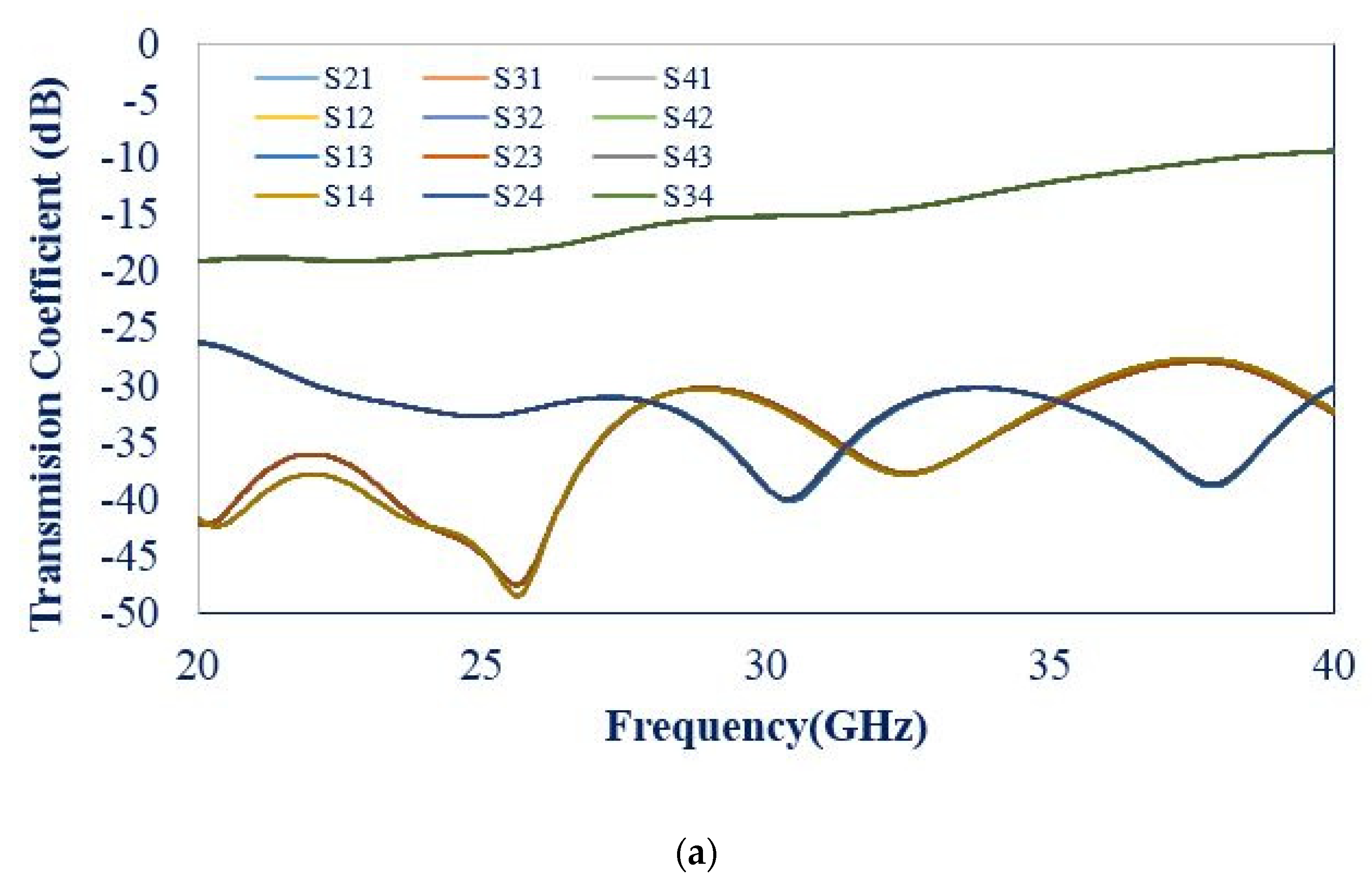Inverted-L Shaped Wideband MIMO Antenna for Millimeter-Wave 5G Applications
Abstract
:1. Introduction
2. Unit Element
3. Element MIMO Design (Case 1)
4. Element MIMO Design (Case 2)
5. Fabrication and Measurement of Case 1 (Three-Element) and Case 2 (Four-Element) Connected Ground Antenna
6. MIMO Diversity Analysis
7. Conclusions
Author Contributions
Funding
Data Availability Statement
Acknowledgments
Conflicts of Interest
References
- Desai, A.; Upadhyaya, T.; Patel, R. Compact wideband transparent antenna for 5G communication systems. Microw. Opt. Technol. Lett. 2019, 61, 781–786. [Google Scholar] [CrossRef]
- Yuan, X.-T.; He, W.; Hong, K.-D.; Han, C.-Z.; Chen, Z.; Yuan, T. Ultra-wideband MIMO antenna system with high element-isolation for 5G smartphone application. IEEE Access 2020, 8, 56281–56289. [Google Scholar] [CrossRef]
- Kulkarni, J.; Alharbi, A.G.; Desai, A.; Sim, C.-Y.-D.; Poddar, A. Design and Analysis of Wideband Flexible Self-Isolating MIMO Antennas for Sub-6 GHz 5G and WLAN Smartphone Terminals. Electronics 2021, 10, 3031. [Google Scholar] [CrossRef]
- Desai, A.; Palandoken, M.; Kulkarni, J.; Byun, G.; Nguyen, T.K. Wideband Flexible/Transparent Connected-Ground MIMO Antennas for Sub-6 GHz 5G and WLAN Applications. IEEE Access 2021, 9, 147003–147015. [Google Scholar] [CrossRef]
- Patel, A.; Desai, A.; Elfergani, I.; Vala, A.; Mewada, H.; Mahant, K.; Patel, S.; Zebiri, C.; Rodriguez, J.; Ali, E. UWB CPW fed 4-port connected ground MIMO antenna for sub-millimeter-wave 5G applications. Alex. Eng. J. 2022, 61, 6645–6658. [Google Scholar] [CrossRef]
- Sharawi, M.S. Printed MIMO Antenna Engineering; Artech House: Norwood, MA, USA, 2014. [Google Scholar]
- Mohamadzade, B.; Simorangkir, R.B.V.B.; Hashmi, R.M.; Lalbakhsh, A. A conformal ultrawideband antenna with monopole-like radiation patterns. IEEE Trans. Antennas Propag. 2020, 68, 6383–6388. [Google Scholar] [CrossRef]
- Kamal, M.M.; Yang, S.; Kiani, S.H.; Anjum, M.R.; Alibakhshikenari, M.; Arain, Z.A.; Jamali, A.A.; Lalbakhsh, A.; Limiti, E. Donut-Shaped mmWave Printed Antenna Array for 5G Technology. Electronics 2021, 10, 1415. [Google Scholar] [CrossRef]
- Sehrai, D.A.; Asif, M.; Shoaib, N.; Ibrar, M.; Jan, S.; Alibakhshikenari, M.; Lalbakhsh, A.; Limiti, E. Compact quad-element high-isolation wideband MIMO antenna for mm-wave applications. Electronics 2021, 10, 1300. [Google Scholar] [CrossRef]
- Sarkar, D.; Srivastava, K.V. Compact four-element SRR-loaded dual-band MIMO antenna for WLAN/WiMAX/WiFi/4G-LTE and 5G applications. Electron. Lett. 2017, 53, 1623–1624. [Google Scholar] [CrossRef]
- Chauhan, D.; Bhalani, J. Performance of nonlinear detectors in spatial multiplexing for spatially correlated channels. Radioelectron. Commun. Syst. 2017, 60, 297–302. [Google Scholar] [CrossRef]
- Elfergani, I.; Rodriguez, J.; Iqbal, A.; Sajedin, M.; Zebiri, C.; AbdAlhameed, R.A. Compact millimeter-wave MIMO antenna for 5G applications. In Proceedings of the 2020 14th European Conference on Antennas and Propagation (EuCAP), Copenhagen, Denmark, 15–20 March 2020; pp. 1–5. [Google Scholar]
- Krishnamoorthy, R.; Desai, A.; Patel, R.; Grover, A. 4 Element compact triple band MIMO antenna for sub-6 GHz 5G wireless applications. Wirel. Netw. 2021, 27, 3747–3759. [Google Scholar] [CrossRef]
- Gao, P.; He, S.; Wei, X.; Xu, Z.; Wang, N.; Zheng, Y. Compact printed UWB diversity slot antenna with 5.5-GHz band-notched characteristics. IEEE Antennas Wirel. Propag. Lett. 2014, 13, 376–379. [Google Scholar] [CrossRef]
- Banerjee, J.; Karmakar, A.; Ghatak, R.; Poddar, D.R. Compact CPW-fed UWB MIMO antenna with a novel modified Minkowski fractal defected ground structure (DGS) for high isolation and triple band-notch characteristic. J. Electromagn. Waves Appl. 2017, 31, 1550–1565. [Google Scholar] [CrossRef]
- Nadeem, I.; Choi, D.-Y. Study on mutual coupling reduction technique for MIMO antennas. IEEE Access 2018, 7, 563–586. [Google Scholar] [CrossRef]
- Kumar, N.; Kiran, K.U. Meander-line electromagnetic bandgap structure for UWB MIMO antenna mutual coupling reduction in E-plane. AEU Int. J. Electron. Commun. 2020, 127, 153423. [Google Scholar] [CrossRef]
- Usman, M.; Kobal, E.; Nasir, J.; Zhu, Y.; Yu, C.; Zhu, A. Compact SIW Fed Dual-Port Single Element Annular Slot MIMO Antenna for 5G mmWave Applications. IEEE Access 2021, 9, 91995–92002. [Google Scholar] [CrossRef]
- Ali, W.; Das, S.; Medkour, H.; Lakrit, S. Planar dual-band 27/39 GHz millimeter-wave MIMO antenna for 5G applications. Microsyst. Technol. 2021, 27, 283–292. [Google Scholar] [CrossRef]
- Sharma, Y.; Sarkar, D.; Saurav, K.; Srivastava, K.V. Three-element MIMO antenna system with pattern and polarization diversity for WLAN applications. IEEE Antennas Wirel. Propag. Lett. 2016, 16, 1163–1166. [Google Scholar] [CrossRef]
- Wani, Z.; Abegaonkar, M.P.; Koul, S.K. A 28-GHz antenna for 5G MIMO applications. Prog. Electromagn. Res. Lett. 2018, 78, 73–79. [Google Scholar] [CrossRef] [Green Version]
- Kamal, M.M.; Yang, S.; Ren, X.; Altaf, A.; Kiani, S.H.; Anjum, M.R.; Iqbal, A.; Asif, M.; Saeed, S.I. Infinity shell shaped mimo antenna array for mm-wave 5G applications. Electronics 2021, 10, 165. [Google Scholar] [CrossRef]
- Raheel, K.; Altaf, A.; Waheed, A.; Kiani, S.H.; Sehrai, D.A.; Tubbal, F.; Raad, R. E-shaped H-slotted dual band mmwave antenna for 5G technology. Electronics 2021, 10, 1019. [Google Scholar] [CrossRef]
- Desai, A.; Bui, C.D.; Patel, J.; Upadhyaya, T.; Byun, G.; Nguyen, T.K. Compact wideband four element optically transparent MIMO antenna for mm-wave 5G applications. IEEE Access 2020, 8, 94206–194217. [Google Scholar] [CrossRef]
- Khalid, M.; Naqvi, S.I.; Hussain, N.; Rahman, M.; Mirjavadi, S.S.; Khan, M.J.; Amin, Y. 4-Port MIMO antenna with defected ground structure for 5G millimeter wave applications. Electronics 2020, 9, 71. [Google Scholar] [CrossRef] [Green Version]
- Rahman, S.; Ren, X.; Altaf, A.; Irfan, M.; Abdullah, M.; Muhammad, F.; Anjum, M.R.; Mursal, S.N.F.; AlKahtani, F.S. Nature inspired MIMO antenna system for future mmWave technologies. Micromachines 2020, 11, 1083. [Google Scholar] [CrossRef] [PubMed]
- Jilani, S.F.; Alomainy, A. Millimetre-wave T-shaped MIMO antenna with defected ground structures for 5G cellular networks. IET Microw. Antennas Propag. 2018, 12, 672–677. [Google Scholar] [CrossRef]
- Alharbi, A.G.; Rafique, U.; Ullah, S.; Khan, S.; Abbas, S.M.; Ali, E.M.; Alibakhshikenari, M.; Dalarsson, M. Novel MIMO Antenna System for Ultra-Wideband Applications. Appl. Sci. 2022, 12, 3684. [Google Scholar] [CrossRef]
- Khalid, H.; Awan, W.A.; Hussain, M.; Fatima, A.; Ali, M.; Hussain, N.; Khan, S.; Alibakhshikenari, M.; Limiti, E. Design of an Integrated Sub-6 GHz and mmWave MIMO Antenna for 5G Handheld Devices. Appl. Sci. 2021, 11, 8331. [Google Scholar] [CrossRef]
- Peng, H.; Zhi, R.; Yang, Q.; Cai, J.; Wan, Y.; Liu, G. Design of a MIMO Antenna with High Gain and Enhanced Isolation for WLAN Applications. Electronics 2021, 10, 1659. [Google Scholar] [CrossRef]
- Sehrai, D.A.; Abdullah, M.; Altaf, A.; Kiani, S.H.; Muhammad, F.; Tufail, M.; Irfan, M.; Glowacz, A.; Rahman, S. A novel high gain wideband MIMO antenna for 5G millimeter wave applications. Electronics 2020, 9, 1031. [Google Scholar] [CrossRef]
- Chung, M.-A.; Hsiao, C.-W.; Yang, C.-W.; Chuang, B.-R. 4 × 4 MIMO Antenna System for Smart Eyewear in Wi-Fi 5G and Wi-Fi 6e Wireless Communication Applications. Electronics 2021, 10, 2936. [Google Scholar] [CrossRef]
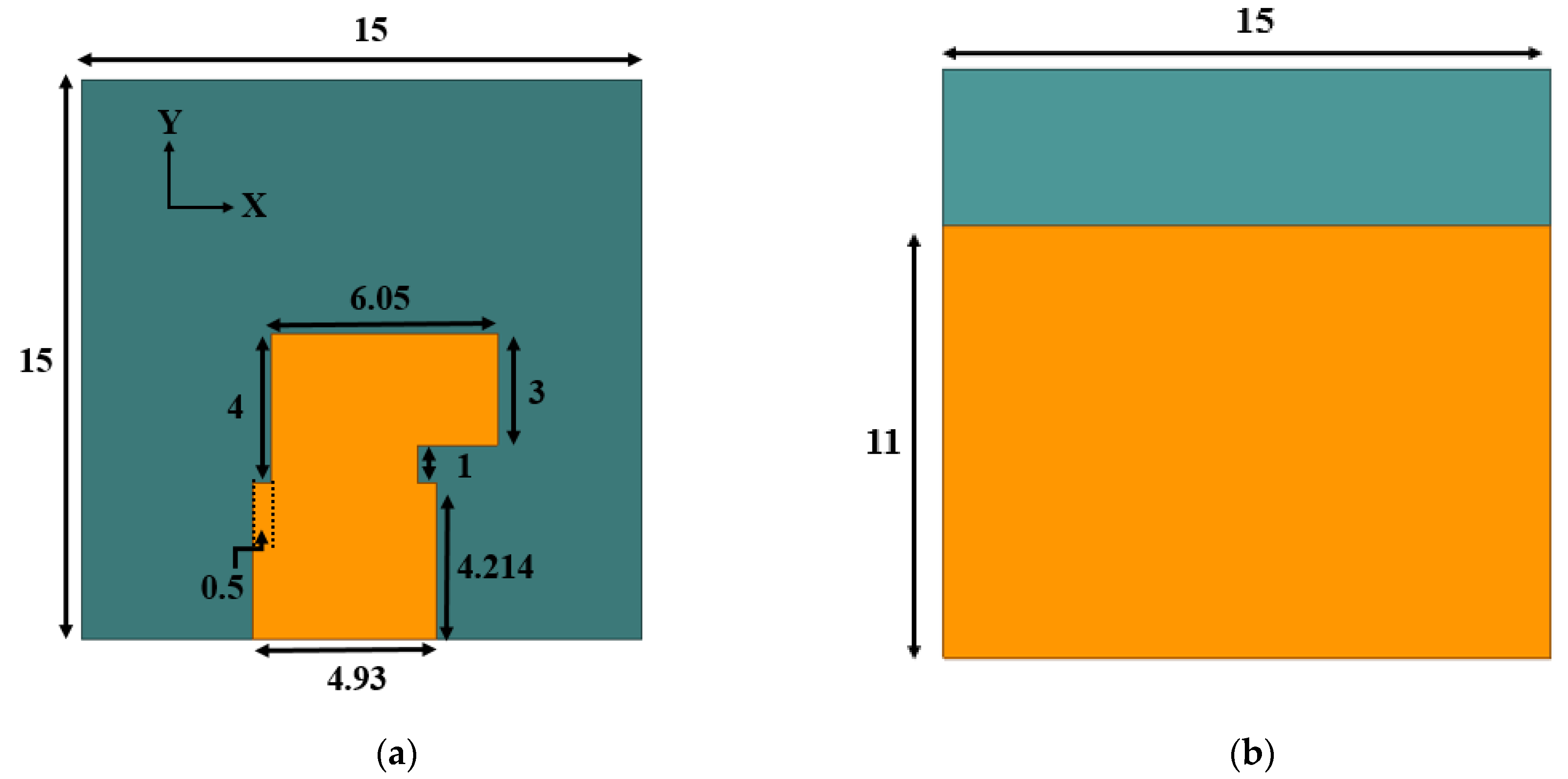
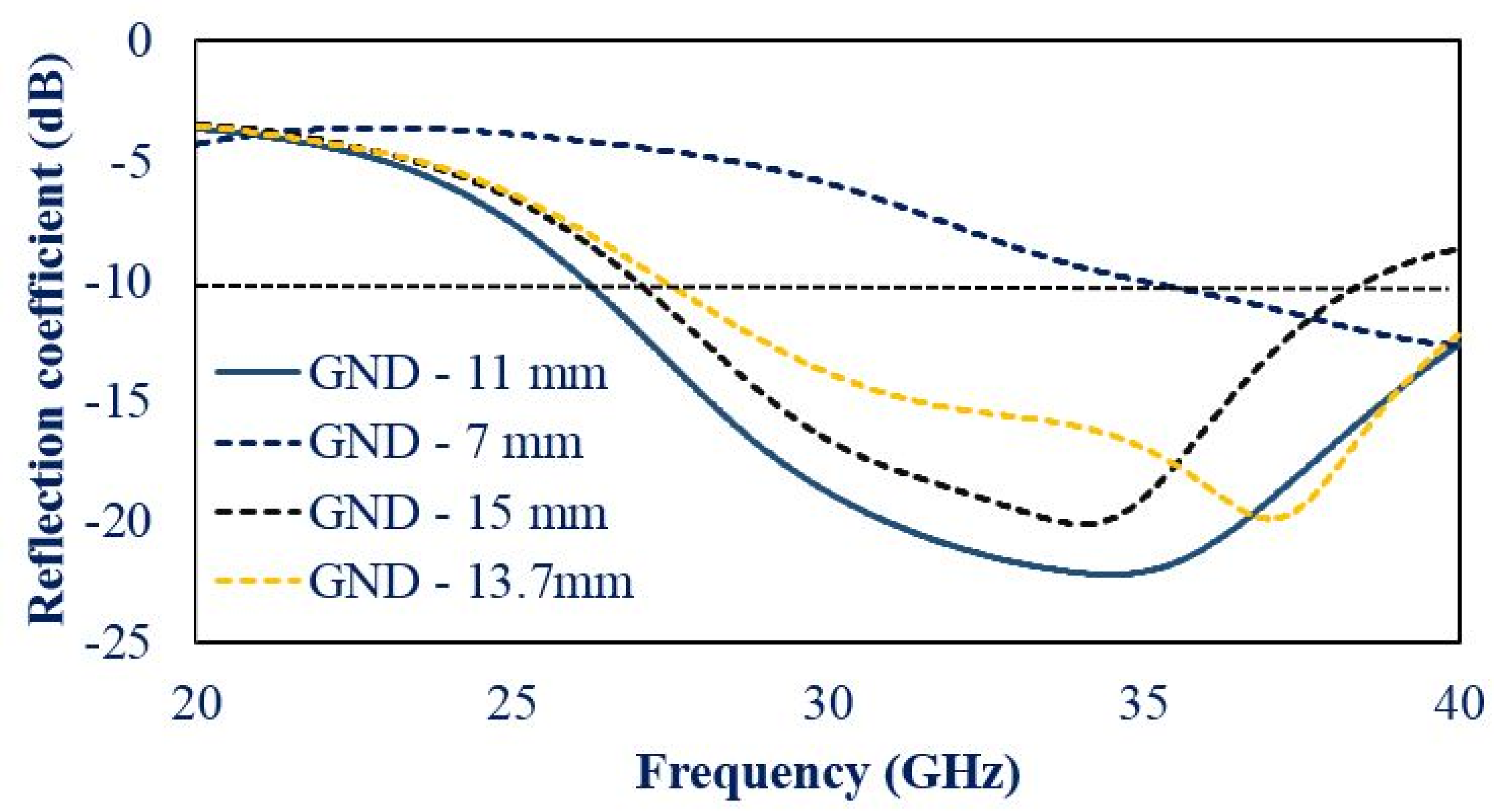
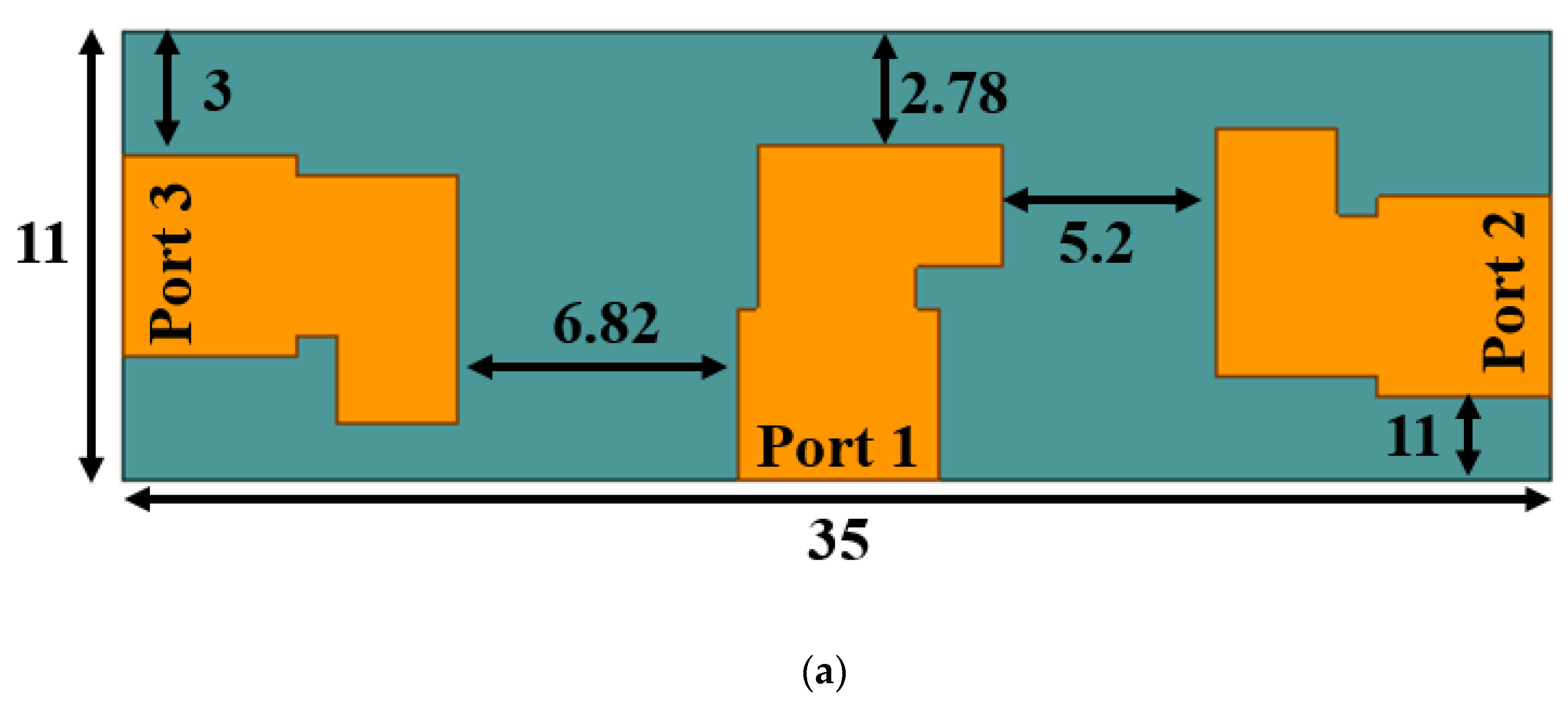
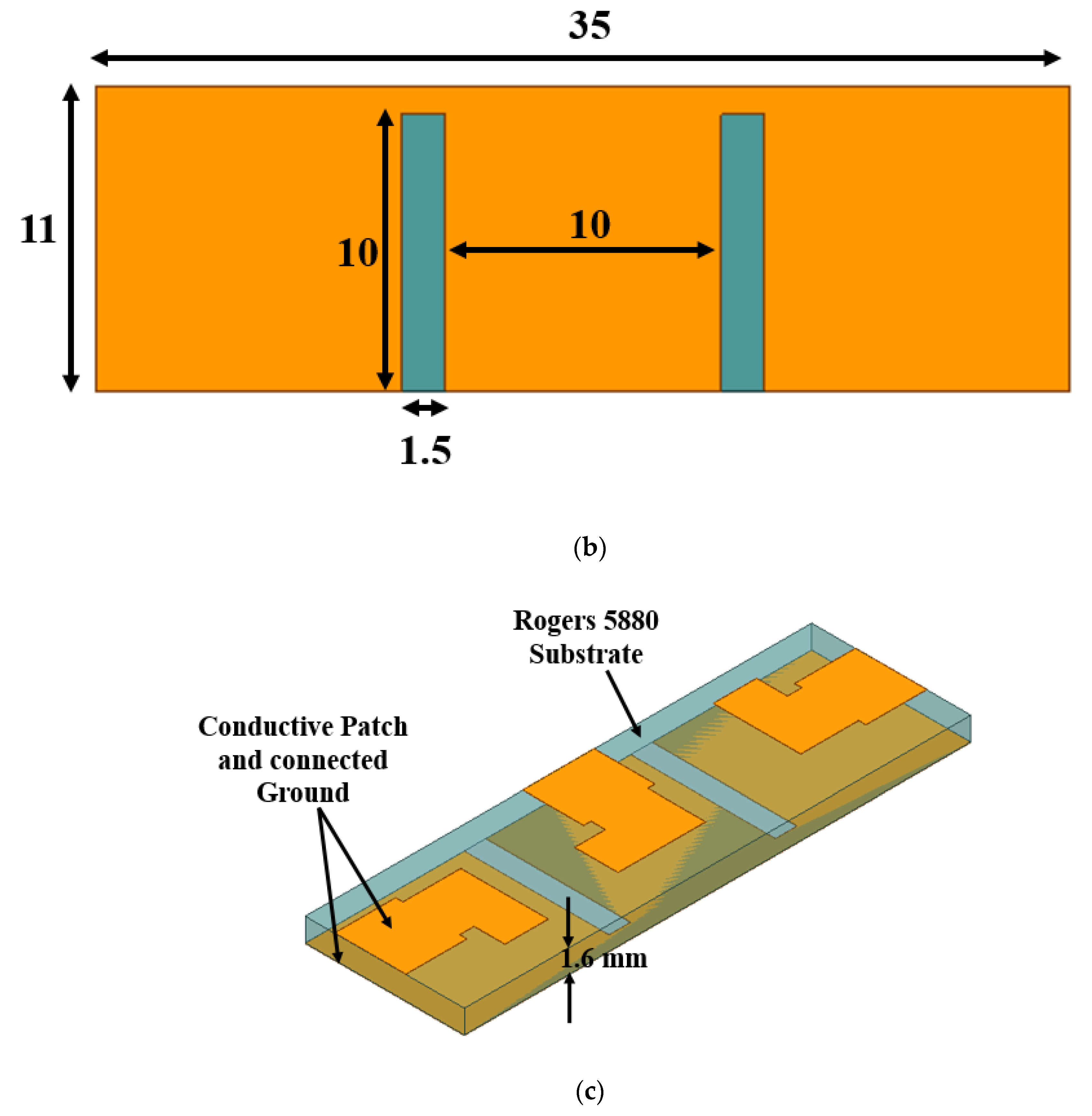

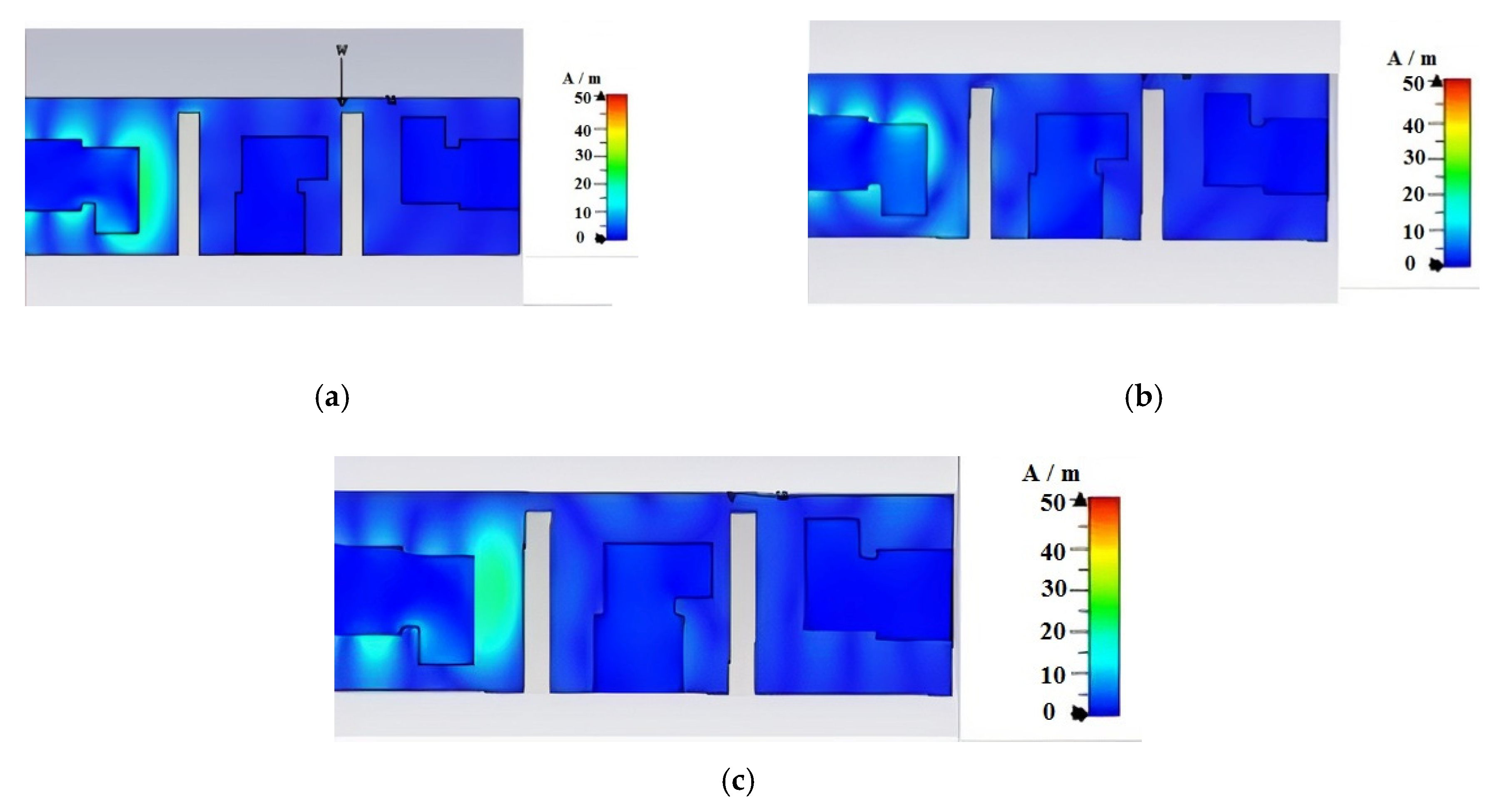

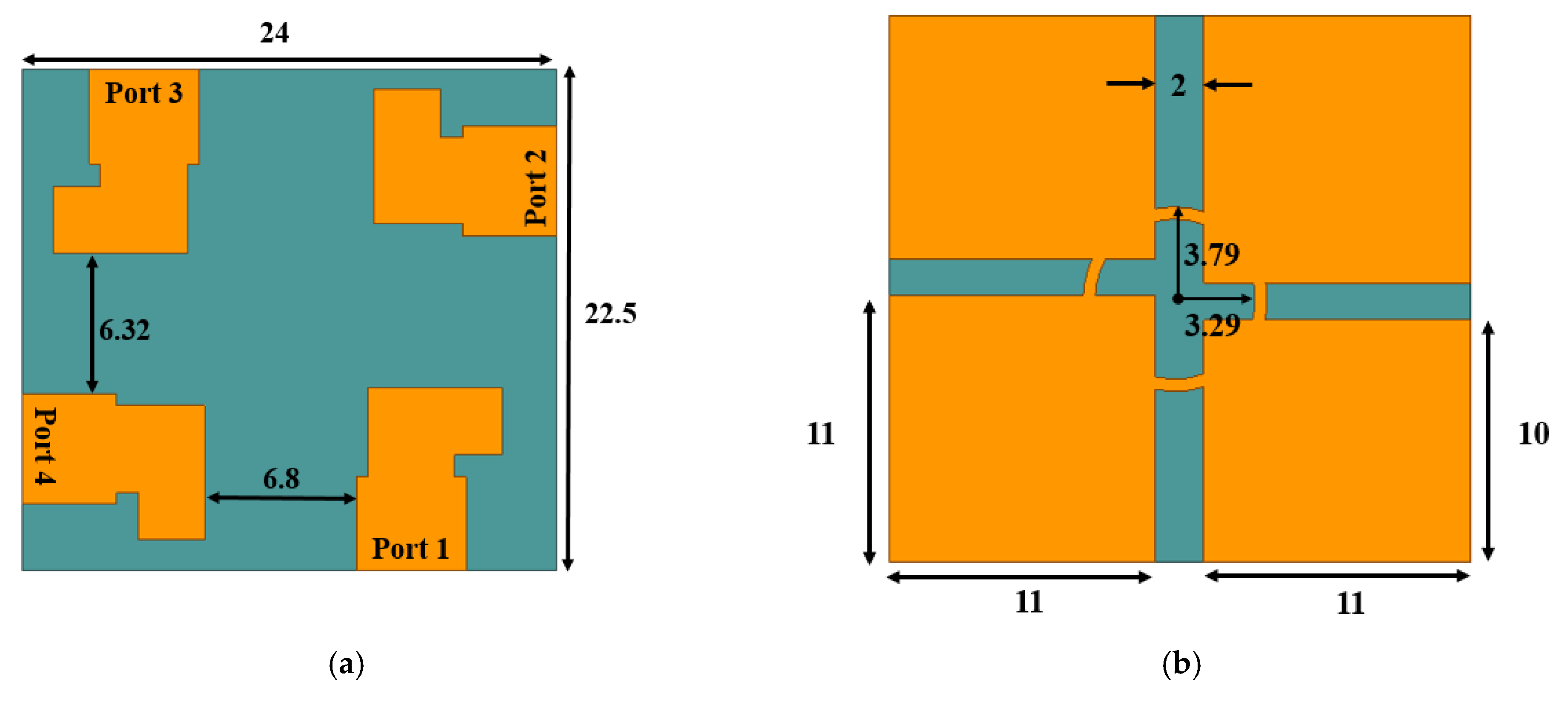
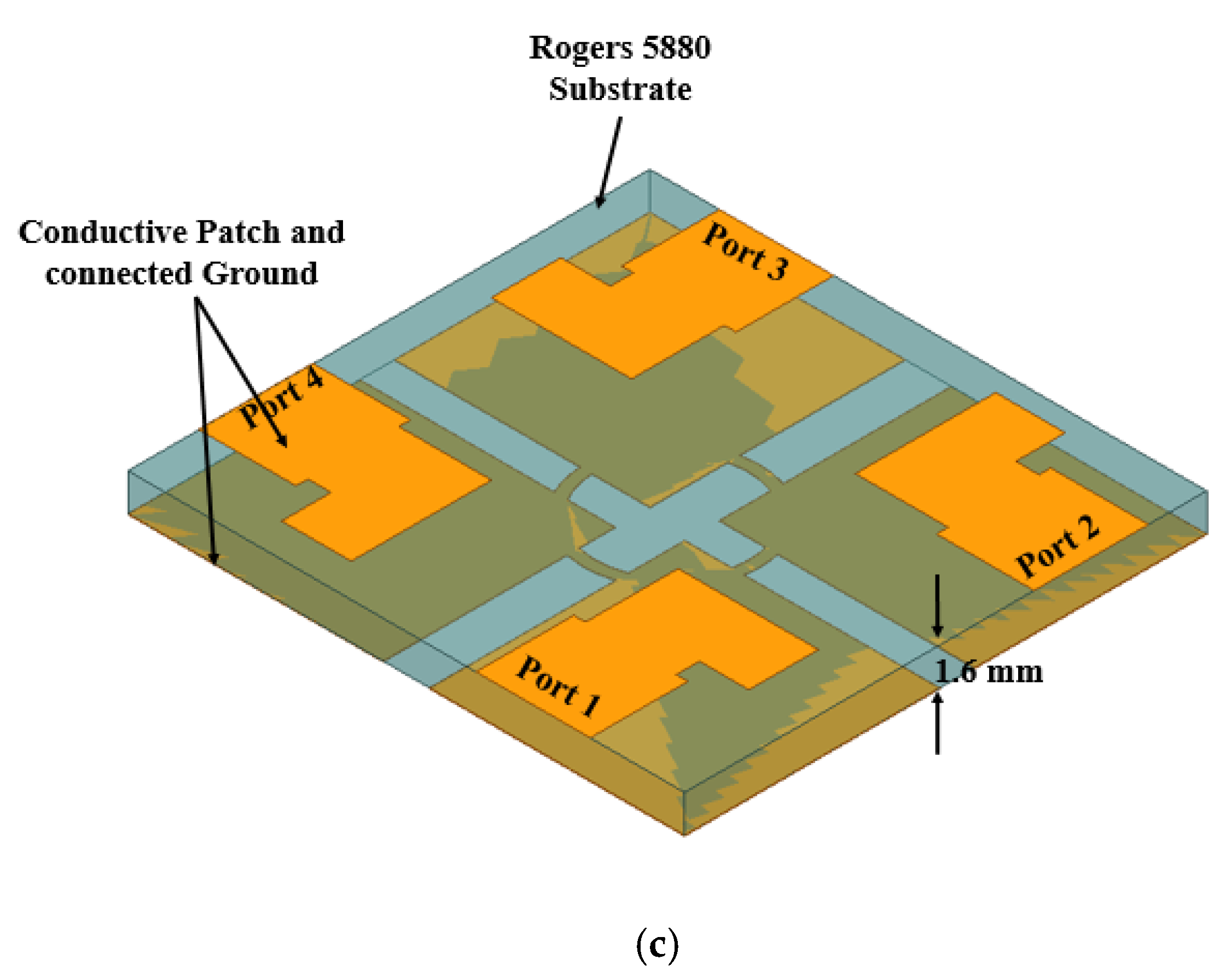
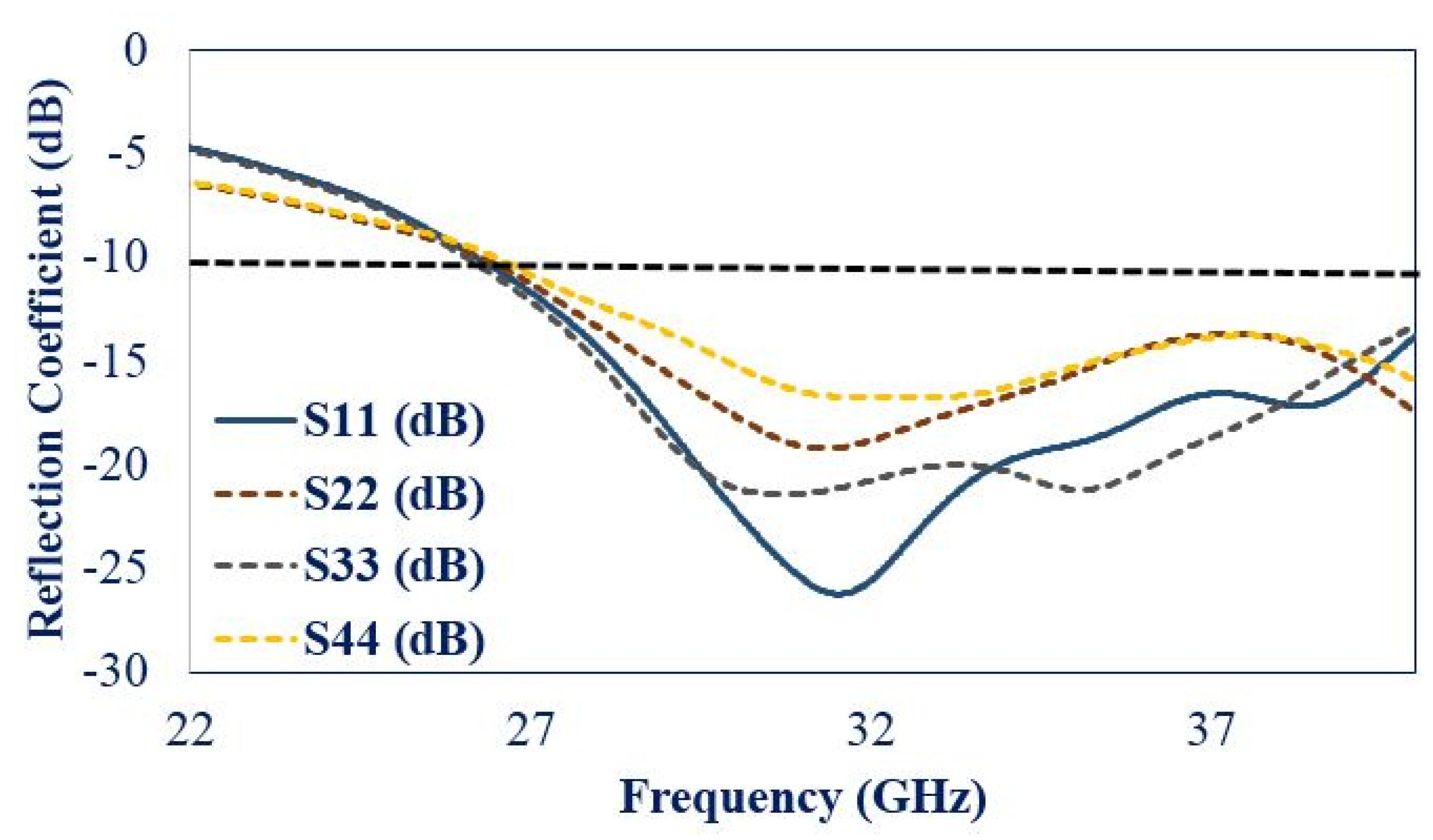



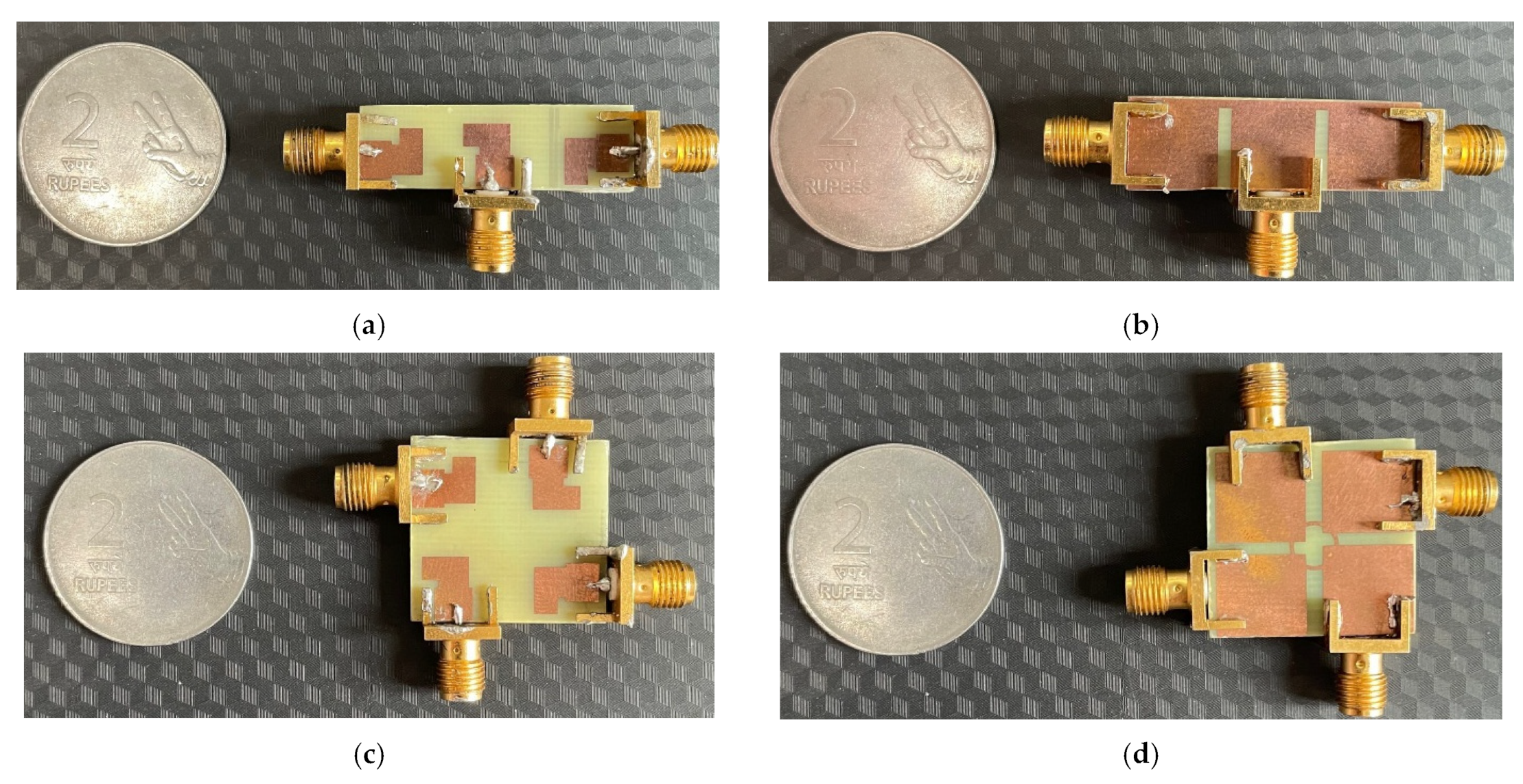
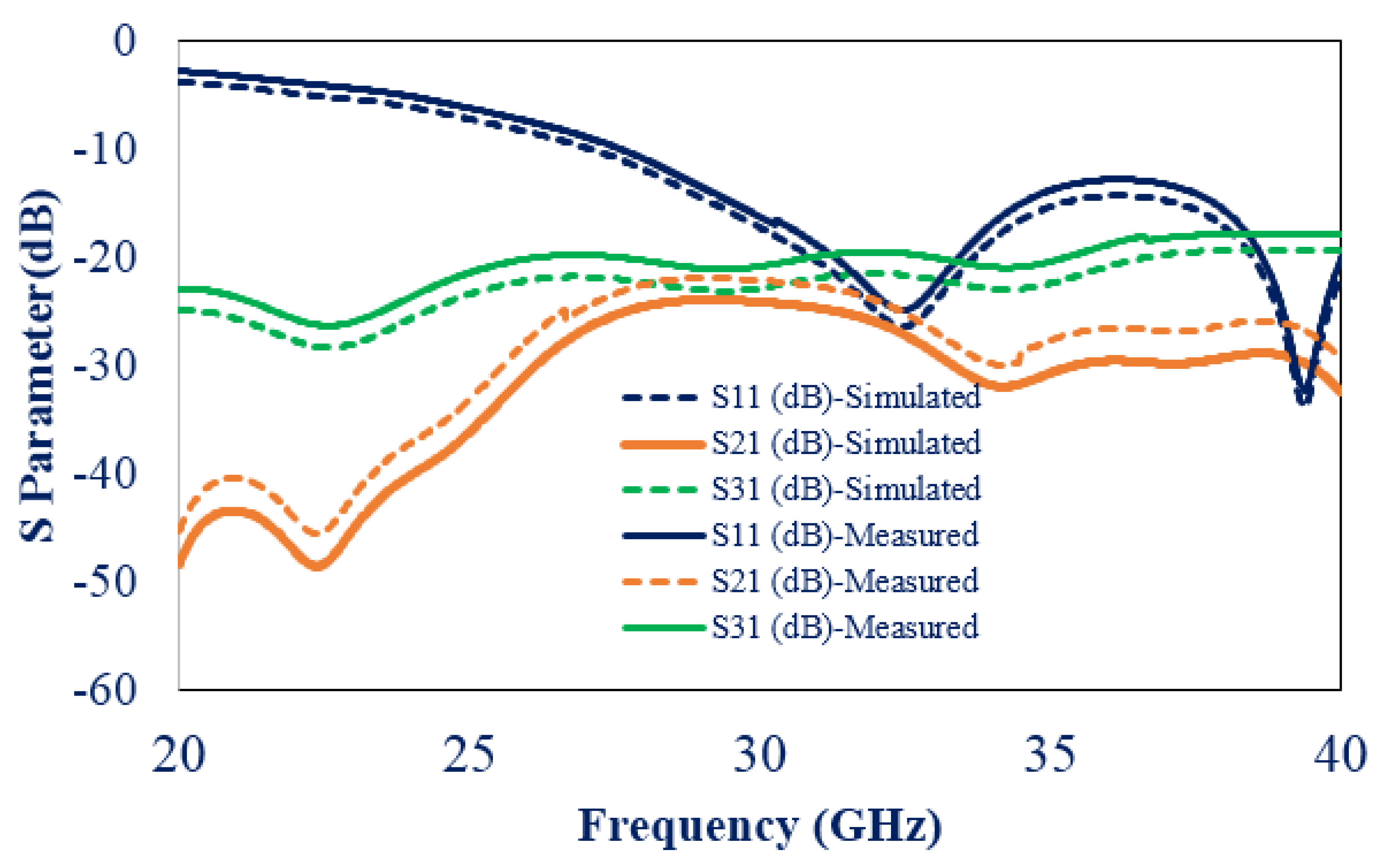

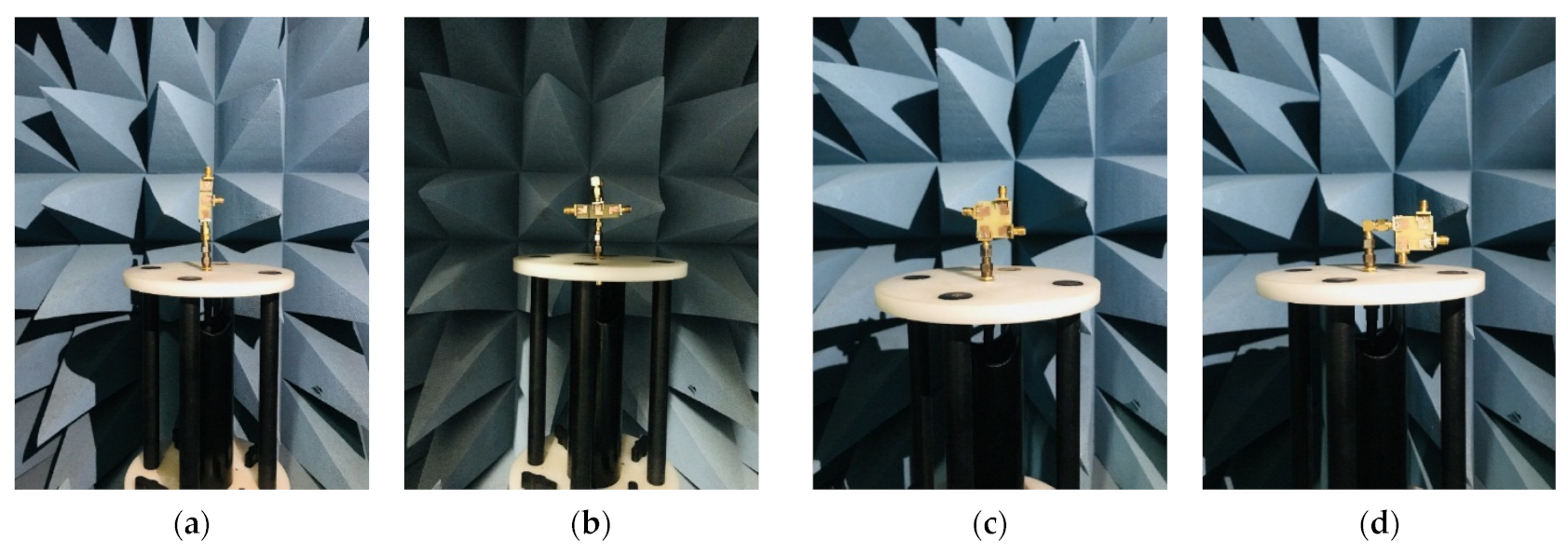

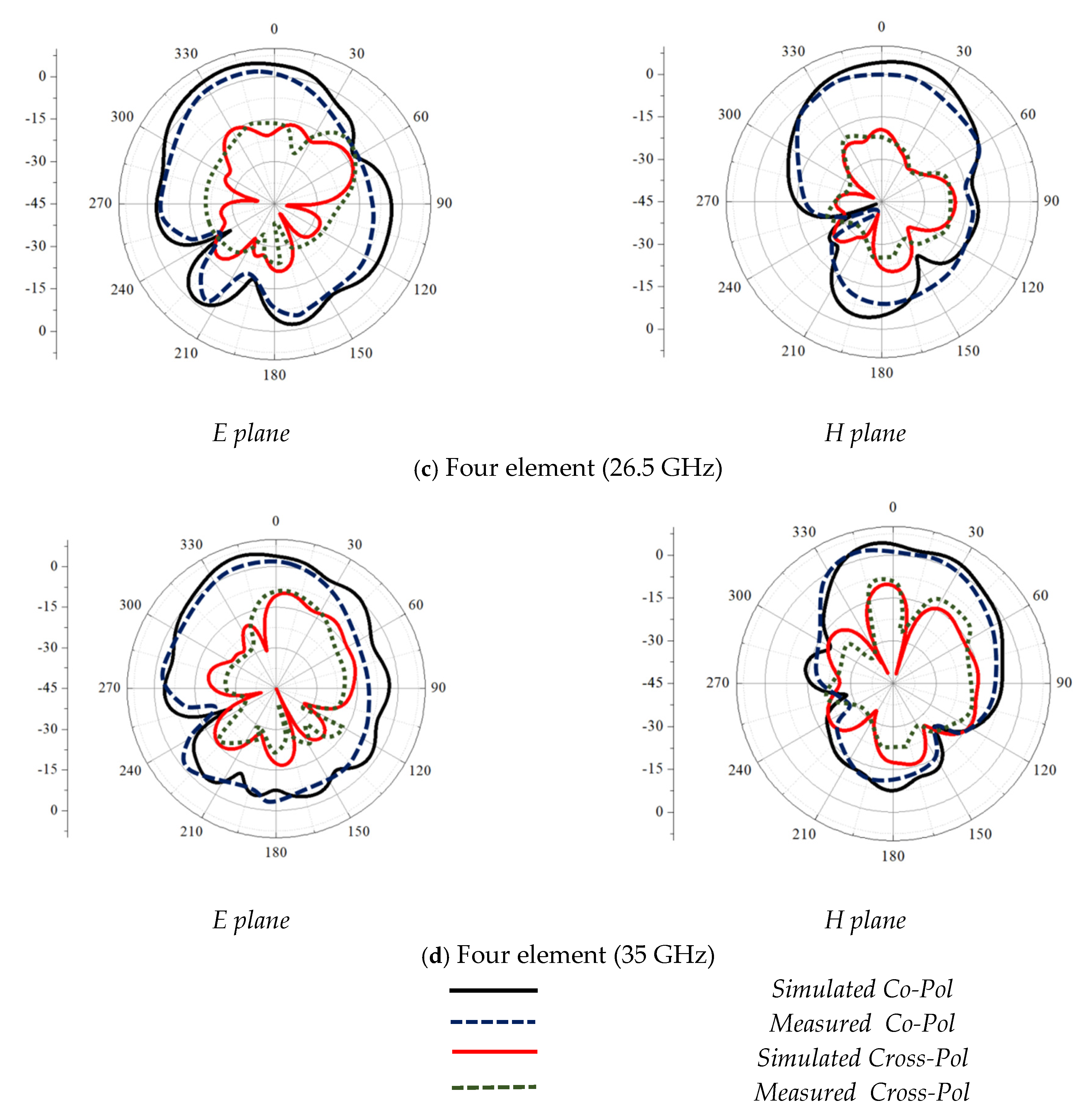


| Ref | Frequency (GHz) | Ports/Ground | Unit Cell Dimension (mm2) | Gain (dBi) | Efficiency (%) | Isolation (dB) | ECC | Material |
|---|---|---|---|---|---|---|---|---|
| [18] | 28 | Two/Connected | 33 × 27.5 | 6.9 | - | >30 | -- | TLY-5 |
| [19] | 26.65–29.2; 36–42 | Two/Separate | 26 × 11 | 5 | 99.5, 98.6 | >25 | <0.002 | Rogers 5880 |
| [21] | 28 | Four/Connected | 30 × 30 | 6.1 | 92 | 29 | <0.16 | Rogers 5880 |
| [20] | 28 | Four/Connected | 48 × 31 | 10 | - | >21 | <0.0015 | Neltec |
| [22] | 27.6–28.6; 37.4–38.6 | Four/Connected | 20 × 24 | 7.9 | >85 | >28 | <0.001 | Rogers 5880 |
| [23] | 24.10–27.18; 33–44.13 | Four/Connected | 24 × 20 | 3 | >80 | >16 | <0.1 | Plexiglass |
| [24] | 25.5–29.6 | Four/Connected | 30 × 35 | 8.3 | - | >15 | <0.01 | Rogers R04350B |
| [25] | 27.5–29 | Four/Connected | 25 × 15 | 7.8 | 95 | >17 | <0.0001 | Rogers 5880 |
| [26] | 25.1–37.5 | Four/Separate | 12.7 × 12 | 5 | 80 | >22 | <0.1 | Rogers 5880 |
| Proposed Three-Element | 26–40 | Three/Connected | 15 × 15 | >5 | >70 | >20 | <0.01 | Duroid5880 |
| Proposed Four-Element | 26–40 | Four/Connected | 15 × 15 | >7 | 60 | >20 | <0.02 | Duroid5880 |
Publisher’s Note: MDPI stays neutral with regard to jurisdictional claims in published maps and institutional affiliations. |
© 2022 by the authors. Licensee MDPI, Basel, Switzerland. This article is an open access article distributed under the terms and conditions of the Creative Commons Attribution (CC BY) license (https://creativecommons.org/licenses/by/4.0/).
Share and Cite
Patel, A.; Vala, A.; Desai, A.; Elfergani, I.; Mewada, H.; Mahant, K.; Zebiri, C.; Chauhan, D.; Rodriguez, J. Inverted-L Shaped Wideband MIMO Antenna for Millimeter-Wave 5G Applications. Electronics 2022, 11, 1387. https://doi.org/10.3390/electronics11091387
Patel A, Vala A, Desai A, Elfergani I, Mewada H, Mahant K, Zebiri C, Chauhan D, Rodriguez J. Inverted-L Shaped Wideband MIMO Antenna for Millimeter-Wave 5G Applications. Electronics. 2022; 11(9):1387. https://doi.org/10.3390/electronics11091387
Chicago/Turabian StylePatel, Amit, Alpesh Vala, Arpan Desai, Issa Elfergani, Hiren Mewada, Keyur Mahant, Chemseddine Zebiri, Dharmendra Chauhan, and Jonathan Rodriguez. 2022. "Inverted-L Shaped Wideband MIMO Antenna for Millimeter-Wave 5G Applications" Electronics 11, no. 9: 1387. https://doi.org/10.3390/electronics11091387
APA StylePatel, A., Vala, A., Desai, A., Elfergani, I., Mewada, H., Mahant, K., Zebiri, C., Chauhan, D., & Rodriguez, J. (2022). Inverted-L Shaped Wideband MIMO Antenna for Millimeter-Wave 5G Applications. Electronics, 11(9), 1387. https://doi.org/10.3390/electronics11091387











